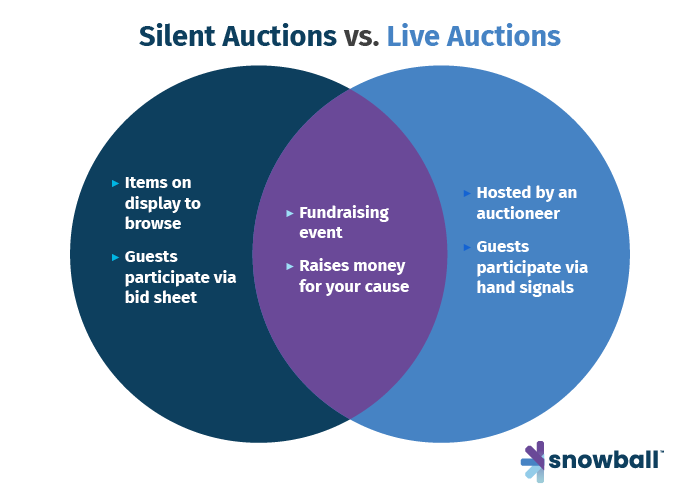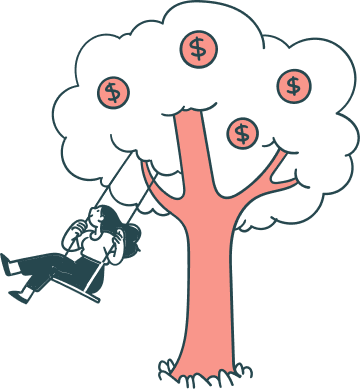Charity auctions are popular fundraising events for schools, faith-based organizations, and other nonprofits. This is largely due to the highly engaging nature of the experience and their historical success with reaching fundraising goals. And although traditional auctions have been around for ages, the rise of virtual auctions is a relatively new trend in the nonprofit space.
That being said, the recent COVID-19 outbreak has continued to move nonprofit fundraisers and other operations further into the virtual realm at a rapid pace as a result of social distancing guidelines.
Here at Snowball, we have the experience and the tools necessary to pull off powerful and effective fundraisers for nonprofit organizations of all shapes and sizes. Whether you are planning your first-ever auction or looking to pivot an existing event to the virtual space, we’re here to help.
Luckily, any big fundraiser or project is easier to digest when it’s broken down into a detailed plan composed of manageable steps. For example, a virtual auction can be completed with these seven stages:
What Is a Virtual Auction?
A virtual auction is simply a charity auction that is hosted online instead of in person. Just like with regular auctions, there are two main types of virtual auctions. The first step in the virtual auction planning process is choosing a type of auction to host. Essentially, that choice comes down to live vs. silent auction. Both silent and live auctions can be held in-person or virtually, but for the sake of this guide, we’ll be discussing the virtual approach.
To understand the key differences between the two, and to make a better-informed decision, take a look at the handy graphic below:

Virtual live auctions
A virtual live auction is one of the most engaging online fundraising events you can host. Picture a high-energy event with a personable auctioneer. You might have held (or attended) a similar event in the past. Then, bring that idea to the virtual realm with live-streaming tools!
If you choose this type of virtual auction, all attendees must log on to your live-streaming platform at a predetermined time. Then, your auctioneer will be broadcast in real-time to participants’ own screens. One item will be auctioned off at a time, while guests are asked to bid via online or mobile bidding tools in quickly increasing increments.
This type of auction does have its limitations, however, in that attendees are limited to those who are able to tune in during a specified time period. If the time selected conflicts with other scheduling priorities, those guests may be unable to participate in your event.
Virtual silent auctions
A virtual silent auction typically takes place over a longer time span, such as a week. While this tends to be a more hands-off approach, it does give you the opportunity to expand your reach significantly and encourage all sorts of supporters to participate.
For a silent auction, guests will be provided access to your online catalog of available auction items. Then, they’ll be encouraged to browse through items at their own pace and bid on those that most interest them.
Because these virtual auctions are more drawn out, it’s important that you have the right tools to keep participants engaged when necessary. For example, it’s unlikely that a guest will be consistently refreshing to find out if they’ve been outbid throughout the week. That being said, make sure you’re able to keep guests updated so that they can increase their bids!
If you’re having a difficult time choosing between the two types of virtual auctions, you might want to consider incorporating elements of each. For instance, you may open bids for many of your items throughout the week, leading up to a real-time finale with a live auction for one or two of your most highly-demanded items.

What Do You Need for a Virtual Auction?
As with any virtual fundraiser, choosing the right fundraising tools is crucial. When it comes to planning your upcoming virtual auctions, adopting a suite of dedicated auction software is an important prerequisite. With so many options to choose from, be sure to keep essential features like these in mind:
Virtual Auction Software: Key Features
1. Online and mobile bidding functionality
One of the main benefits of virtual auctions is increased accessibility. In other words, supporters from far and wide are able to log in and participate—that is, as long as they have the technology required by your auction software.
That being said, it’s crucial that your software is easy-to-use on all sorts of devices and browsers. Otherwise, you risk excluding potential guests from participating in your auction, even if unintentionally.
Plus, mobile bidding tools allow auction participants to bid on the go, regardless of where they are and whether they’re parked in front of their computers.
2. Real-time notifications
Whether your attendees are participating from their smartphones, tablets, or desktop computers, it’s important that you’re able to effectively update them on auction progress. For example, users should be immediately informed when they’ve been outbid so they have the opportunity to up their bid again. Additionally, winners should be notified as soon as bidding closes.
The ability to deliver notifications to your auction attendees is a crucial part of keeping your audiences engaged. Otherwise, it’s hard to encourage the bidding war attitude, which is what really drives prices through the roof!
3. Buy-now options
Although the big idea behind an auction is to have participants bid on items, having the ability to turn on the “buy now” function can be extremely efficient. This way, you can sell raffle tickets and other fixed-price items to your auction-goers. Plus, some attendees may prefer to have the option to purchase items on-demand rather than participate in a slowly increasing bidding war.
When doing so, it’s important to make sure your purchase price is high enough that you’ll still make a profit. For example, we recommend setting your “buy now” price at approximately 130-150% of the estimated retail value.
4. Automated email receipts
Whenever an individual makes a purchase, whether that’s at the grocery store down the street, a fast-food drive-thru, or an online retailer, the buyer tends to expect a receipt. Your virtual auction is no different!
Many consumers use receipts for taxes and bookkeeping purposes, plus it gives you a nice opportunity to thank them for their participation in your event.
Finding and utilizing auction software that automates the receipt distribution process can be a huge time-saver on your part. You ensure each guest receives correct documentation of their purchase without spending your own valuable time doing so.
5. Streamlined checkout
We’ll go more in-depth on the importance of an effective checkout process below. Regardless, it’s crucial that your software provider places an emphasis on streamlined checkout. That can mean collecting payment information quickly and conveniently once the bidding has closed, having the power to handle multiple transactions simultaneously, producing automatic invoices, or (hopefully) all of the above.
Our favorite auction software? Snowball’s powerful suite of virtual auction tools. Our online and mobile bidding software is perfect for in-person and virtual auctions alike. Plus, it’s the best value on the market.
Supplementary software:
In addition to your online auction tools, there are other software solutions that your nonprofit should consider investing in. Take a look at some of the following options to determine if your fundraising efforts could benefit from these tools:
Matching Gift Software
Double the Donation is a highly respected matching gift software provider. If your nonprofit is interested in securing corporate gifts on behalf of your existing supporter base, you have to invest in either a matching gift database for your supporters to complete their match requests, or a matching gift automation platform, which will supercharge your existing matching gift program.
T-Shirt Fundraising Platform
If you’re planning on selling branded swag at your event, make sure that you create it with a platform that is designed for nonprofits and can help you collect more donations with ease. Bonfire is a top-notch t-shirt fundraising platform that allows nonprofits to create gorgeous merchandise including hats, sweaters, mugs, and bags for free, with no inventory requirements.
Volunteer management software
If your event relies on volunteers, you’ll need volunteer management software. This platform will allow you to schedule your volunteers, communicate with them easily, and keep track of the hours that they spend working with your organization.
Virtual Auction Catalog
Your online auction catalog is likely to be your most powerful marketing tool. After all, it is essentially a virtual window into your auction. Your catalog allows event attendees and other potential guests to take a look at your offerings and make a decision about whether or not to participate.
- Provide a sneak peek. Prospective guests will be more likely to engage with your upcoming virtual auction if they have some idea of the items that will be up for bid. That’s why it’s a great idea to publish your auction catalog a bit ahead of time to help garner support.
- Include high-quality images. Powerful imagery is arguably the most important component of effective virtual auctions. That’s because due to the online nature of the event, participants will not be able to touch, feel, or see your auction items up close.
- Provide detailed descriptions. After your high-quality images of each item in your online auction catalog should be a detailed and vivid description. This can be useful for visually-impaired guests, as well as providing a general opportunity to emphasize each item’s main selling points.
- List the starting bid. The starting bid for each item should be strategically decided and listed in your catalog. This way, guests can get a feel for the kinds of items they think they can reasonably afford to bid on. To choose the starting bid, we recommend around 30% of the item’s estimated retail value.

How Do You Do a Virtual Auction? 5 Steps
1. Procure your auction items.
The items you procure are essentially the stars of any virtual auctions you host. That’s why this step is one of the most important on your checklist. Lucky for you, we have a few tips to help out.
How to procure items
Auction item procurement is still a fairly big task, so it might help to break it down even further. Here are four actionable steps to take in order to ensure a streamlined and effective procurement process:
- Form a procurement team of staff members and volunteers.
A good-sized procurement team will consist of approximately 5-6 individuals. You want enough that the work is spread out so as not to overwhelm any individual member, but not too many that the team becomes difficult to manage. Then, within the team, be sure to designate a specific leader to help run your operations and keep everyone else on task. - Begin approximately six months in advance of your event. The longer you wait, the more stressful the procurement process will be. Not to mention, you risk losing out on potential auction items and support. Remember, you’ll need to have a completed catalog ready before your auction in order to use it to draw in top bidders. We suggest getting started about six months out.
- Create a detailed and specific donation item wish list. The more specific and targeted your fundraising asks, the more likely your prospects will be to comply. Providing potential donors with an auction item wish list tends to take a lot of the stress off your supporters and your team members. Be sure to include a wide price range, so that donors can choose an item or category that they’ll reasonably be able to contribute.
- Reach out to local businesses and major donors. When you work with restaurants, shops, and other businesses in your community, you lay the foundation for powerful corporate partnerships. Such a relationship can be a fantastic perk to both you as the fundraiser and the business in question by providing unique promotional opportunities and increased corporate social responsibility. Be sure to request donated and discounted goods, services, and gift cards from your favorite local companies.
As far as individual donors go, you may have generous supporters in your vicinity who are willing to donate either auction items from your wishlist or financial contributions to your fundraiser. It never hurts to ask!
Popular auction items
If your team is not sure where to start, narrowing down the list of potential auction items can seem a bit overwhelming. These are some of our favorites:
Travel packages. A travel package is likely one of the most popular auction items of all time. Be sure to include a fully-paid stay at a nice hotel or vacation home rental, along with transportation to get there, and perhaps a few activities to fill the time.
Gift cards. Reach out to local businesses and see if they’ll be willing to donate gift cards to some of the favorite coffee shops, eateries, and other shops in your area. That way, supporters are able to obtain gift cards at a discounted rate, and you can offer promotional opportunities to your business partner—all the while, proceeds go toward a good cause.
Artwork. If you’re fundraising for a school, a church, or another youth-based program, it’s a great idea to auction off student-made artwork for a more personal and unique touch. Just be sure to get high-quality photos of each piece prior to the event to really show off the talent in your virtual catalog.
Baskets. Auction baskets are fun and exciting for participants because they’re often composed of an assortment of goods that an individual may not typically purchase for themselves. The types of baskets you could create are unlimited. Some of our favorites include a wine and cheese basket, pampering/at-home spa basket, or camping trip basket.
Experiences. Things like private plane rides, hot air balloon excursions, and exclusive behind-the-scenes tours are always popular items at charity auctions. Think of it this way: If it’s something an individual might have on their bucket list, it will likely make for a memorable and high-demand auction item.
For more examples of top auction items that sell, be sure to check out our more comprehensive guide.
One thing to keep in mind is that it is possible to have too many auction items. While this might seem unintuitive, virtual auctions with too many items can actually spread bids too thinly and decrease overall revenue. Instead, the most successful auctions focus on one or two big-ticket items supplemented by a range of smaller and mid-range priced items.

2. Promote your event and items to generate excitement
It’s a good idea to incorporate a combination of directed invitations along with a generalized mass marketing strategy. This way, your dedicated donors and other supporters will receive a personalized message encouraging them to attend, while other individuals within your network of support can find out about and choose to attend your event as well. It’s a win-win!
Let’s discuss a few of the most common marketing and outreach strategies for fundraising events like yours:
Direct mail
Sending out physical invitations via direct mail is a great way to raise awareness about your upcoming event and keep your mission top of mind. It’s like receiving a personal invitation to a birthday party!
The power of direct mail is often overlooked, or worse, considered to be an out-of-date strategy. However, in a world that is constantly vying for your supporters’ attention online, sometimes sending a physical invitation in the mail is exactly what you need to stand out.
Email is a favorite method for communication with donors, and for good reason. With just a few clicks, you can send personalized invitations to thousands of supporters at once. Plus, you can include a bright and eye-catching call-to-action at the end that directs readers to your event landing page or registration form.
It’s a good idea to create a segmented email marketing strategy as well. That way, you can send more targeted messages to your supporters based on characteristics like their engagement history, previous donations, and event registration status.
Phone call
For major donors and other significant supporters of your organization, it’s a good idea to take time out of your busy schedule and give them a phone call. That way, you can catch up, see how they’re doing, and invite them personally to your upcoming auction.
When you invest the time and effort to reach out to donors like this, they can see that they play a big role in your mission. This creates deeper emotional connections to your cause and encourages longtime interpersonal relationships.
Be sure to share important information such as the date and time frame of your virtual auction over the phone. However, you’ll want to send out a follow-up email as well. That way, supporters will have the details in writing to refer back to.
Social media
More than likely, your organization already has a social media profile or two. Sites like Facebook, Instagram, and Twitter make powerful and effective platforms for getting the word out about future fundraising events. Be sure to inform your followers about your upcoming virtual auction and direct interested users to your online registration page.
It’s a good idea to start promoting your event a few months in advance, with the relevant communications getting increasingly specific and timely as the auction approaches. For example, you can promote a different “featured item” each week leading up to the auction. Be sure to include more specific information about that item along with details about the overall event.
Perhaps you can link to the entire online catalog, or maintain a sense of mystery by releasing a single item at a time. Either way, this can be a great strategy for boosting excitement via email, social media, or a combination of the two!
Google Ads
Paid advertising is a phenomenal way to increase visibility for your virtual auction and boost participation. Even if you’re operating on a limited budget, you can leverage resources like the Google Ad Grant, which provides free ad credits to eligible organizations. That way, you can invest more into the auction itself, rather than overspending on promotion.
Once you publish your event landing page, use Google Ads to boost it for relevant keywords like “charity auction” or “online fundraising auction.” Be sure to use attention-grabbing headlines and descriptions highlighting the benefits of participating. To drive more clicks, include key details like unique items up for bidding and how proceeds will support your cause. You can even use targeting options like location, age, and interests to ensure your ads reach the right audience.
At any point, you can outsource the work to a Google Grants agency, which can eliminate the program’s learning curve and get your auction’s promotional efforts off the ground. In any case, using Google Ads to promote your virtual auction means you can drive participation in targeted, measurable, and effective ways. In turn, you’ll maximize the impact of your marketing efforts.
3. Begin accepting bids.
Before you begin accepting bids, it’s important to determine a time frame for when and for how long you’ll accept bids. The time frame for your virtual auctions will depend on the type of event you’ve chosen to host. Regardless, most auctions will fall into one of the following categories:
A single night
A live virtual auction will typically take place within the span of a single night, usually about an hour or two, depending on the number of items up for bid.
Because the hope is that your participants will tune in and stay tuned throughout the duration of the event, you don’t want it to take an unnecessarily long time. Otherwise, you’ll start losing attendees toward the end of your programming, and the last few items may not get the attention they deserve.
In order to account for working guests, most live auctions don’t start until around 6:00 p.m. That way, you can give the majority of your supporters time to settle in and get ready to bid!
Several days
On the other hand, virtual silent auctions can take from a few days up to a full week. That’s because rather than claiming your participants’ undivided attention for a time period, auction attendees can bid continuously on the go, from wherever they are.
For example, you could open bids on a Monday, encourage auction participation throughout the entire week, and come to a big conclusion on the following Sunday evening. This way, your supporters from all over the world are able to participate in their own timeframe, regardless of changing time zones and other commitments.
4. Engage with supporters virtually during the auction.
Due to the remote nature of a virtual auction, participants may be wondering when and how they’ll receive their winnings. As opposed to a traditional in-person auction where winners can simply checkout and leave with their items, virtual auctions require you to package and ship items accordingly.
That being said, it’s a good idea to take a proactive approach to the process by explaining the next steps to all your winners. For example, it can be useful to give an estimated time frame during which participants can expect their items in the mail.
In addition to this, you want to make sure that your staff is engaging with all attendees and is available to answer questions. Have them check in on participants periodically to ensure that there are no issues as well as to simply interact with supporters.
5. Distribute items and express gratitude.
Check-out and delivery of items is one of the most important steps in the virtual auction process. That’s because your check-out stage is likely the last memory that guests will form about your event, which can leave a lasting impression about your organization. In other words, a clunky, lengthy, or disorganized check-out can potentially override positive memories of an otherwise successful event. You definitely don’t want that.
In order to ensure an optimal experience from start to finish, here are a few things to keep in mind:
Ship items in a timely manner.
You don’t want guests to start getting antsy, worrying about where their auction items are and whether they’re still coming. Be sure to ship items as soon as possible following the conclusion of your auction, and perhaps spring for an expedited shipping choice.
Plus, if possible, it’s a good idea to provide each winner with the tracking code for their package. This way, each individual will have a better understanding of the shipping timeline, and you can avoid constant check-ins from impatient winners seeking their prize.
Include a handwritten thank-you note.
A handwritten note is a personal way to thank each of your guests for participating in your virtual auction.
Plus, it’s a good idea to include a brief summary of the impact their gift will make on your mission. For example, if you’re fundraising for a community animal shelter, you can
Virtual auctions tend to require a lot of effort during the planning process—especially if it’s your first one—but the ROI can be incredible! Between the fundraising revenue collected and the increased engagement with your nonprofit supporters, you might start wondering why you haven’t adopted this strategy even sooner.
If you’re looking for more informational resources, check out our other favorite fundraising guides:
- Auction Items | 101 Best Ideas [& Tips for Procuring Them] Now that you know the steps involved in planning and hosting a virtual auction, it’s time to get started on the item procurement process. Check out our 50 favorite suggestions with this guide.
- Online Fundraising in 2020 | Complete Guide and Resources: Virtual fundraising has become non-negotiable for nonprofit organizations of all shapes and sizes. Read up on our comprehensive guide for effective tips and best practices to raise more online.
- Fundraising Events | 60 Proven Ideas to Raise More: Fundraising events (like virtual auctions!) are powerful ways to gather financial support while building stronger relationships with your supporters. Be sure to read about our favorites to get started.





